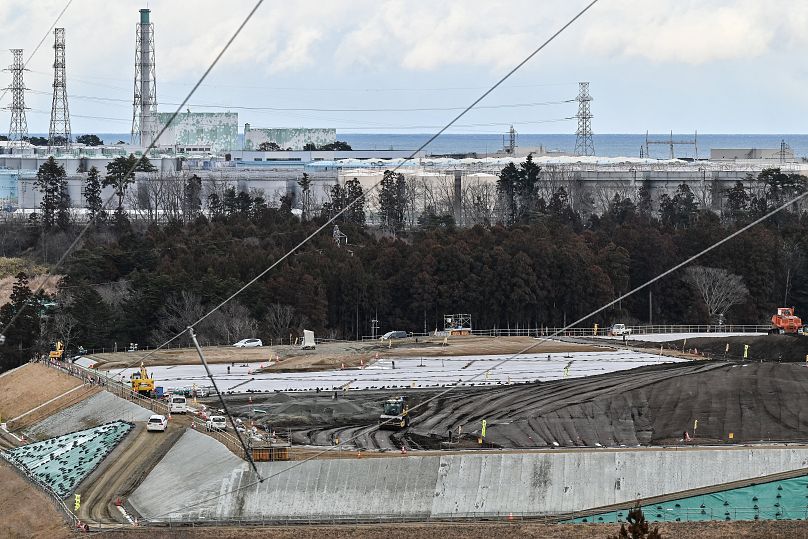As Japan is locked in a scallops standoff with China and Russia, with wider political ramifications, Tokyo reassures consumers worldwide about its seafood safety and looks for new markets. Euronews Business breaks down what it is all about.
While most of the world has been watching the Israel-Hamas conflict and other geopolitical developments in the last few weeks, China and Japan’s seafood war has notched up a level.
This was first started following Japan releasing its treated wastewater from the Fukushima nuclear disaster back in 2011 into the sea, quickly prompting a seafood ban from Japan’s largest seafood importer, China. Together with Hong Kong, China accounts for about 40% of Japanese seafood exports.
Japan has recently started releasing its third batch of wastewater, of about 7,800 tons, on November 2, which is expected to go on until November 19.
Russia, China’s long-term communist ally also quickly followed suit with its own ban. South Korea has also reiterated its previous complete ban on seafood coming from eight Japanese prefectures. These include Gunma, Ibaraki, Tochigi, Fukushima, Aomori, Iwate, Miyagi and Chiba. Other Southeast Asian countries such as Malaysia have also expressed concerns about Japan’s Fukushima wastewater disposal, but have not come forward with any bans.
Scallops have been especially impacted by these bans, as they are one of the most expensive and sought-after seafoods, with Japan exporting about 100,000 tons of scallops to China in 2022.
China is using trade bans as a coercion technique
China’s ban is based on the World Trade Organisation’s phytosanitary measures rules, with accusations of Japan treating the sea like its own “personal sewer”. However, the country has also systematically led a disinformation and smear campaign, discrediting scientific reports and information.
This is mainly being done using skewed reporting and paid social media campaigns, against the Japanese seafood industry, causing seafood sales in China to plummet significantly. Not only that, but Japanese businesses, schools and diplomatic missions based in China have also faced trouble.
China’s move has been condemned by the US and EU as more political than motivated by environmental welfare concerns. This is largely due to the country already having employed similar trade bans and measures to “punish” or express its displeasure with other countries and international measures.
This was seen when China banned South Korean goods, following the country supplying the US with anti-missile batteries in 2017. Back in 2010, Japan also faced ire with China refusing to export critical minerals, as conflicts in the East China Sea grew. More recently, a number of Australian goods have faced restrictions, following the nation suggesting more thorough investigations into where the COVID-19 virus actually came from.
US supports Japanese seafood industry
In September 2023, as a result of China’s ban, Japanese seafood exports tanked about 90.8%. Although Japan has already ramped up subsidies for the fishermen and companies that need them, it is unclear how long these can potentially be sustained. The fall in prices of local seafood, and oversupply continue to remain significant concerns. Currently about $140 million (€128.7 million) has been announced as stimulus measures and subsidies.
However, domestic Japanese consumers are also rallying in favour of the sector, with local seafood consumption rising quite a bit in solidarity, boosted by nationalistic pride against Chinese measures. Fukushima fish is being particularly sought out, despite worries of it taking a special hit.
The US has also been trying to support the Japanese fishing sector by increasing its seafood imports from the country, with the US military troops already stationed in Japan signing a long-term contract to bulk-buy fish from Japanese co-ops and fisheries.
This move is largely to counter what is being seen as China’s coercion and manipulation in the Southeast Asian region, through its influence on global supply chains. US and EU ambassadors have also eaten Japanese scallops and other seafood on camera in the last few weeks, as well as allowing them to be served to their families.
Is the wastewater disposal actually dangerous?
According to Japan, the disposal of the treated wastewater is perfectly safe, with the International Atomic Energy Agency (IAEA) also backing up this narrative in their latest report. Furthermore, the release of the nuclear wastewater will be spread out over 30 to 40 years. Currently, Japan measures the levels of tritium in seawater daily, which clocks in somewhere between 63 and 87 becquerels per litre of seawater, much below the 1500 becquerels limit imposed by the government.
Not only this, but external experts from China, Canada, South Korea and the IAEA will also soon be visiting Japan to collect seabed, soil, sediment, seawater and fish samples. They will independently compare these results to last year’s findings in order to ascertain whether there has been significant deterioration that can be linked to the wastewater release.
China’s move is also being called hypocritical, as it itself disposes of tritium into the sea and is also still allowing its own fishermen to fish in the same waters that Japanese wastewater is going into. This Japanese campaign is also being seen as China’s efforts to distract its population from its own economic woes, such as rising youth unemployment and a wobbly real estate sector.
This can also be seen as another way for China to ascertain itself as the Champion of the Global South, echoing Southern Pacific islander nations’ concerns with nuclear wastewater and marine ecosystem deterioration.












